Will the world become one and end?
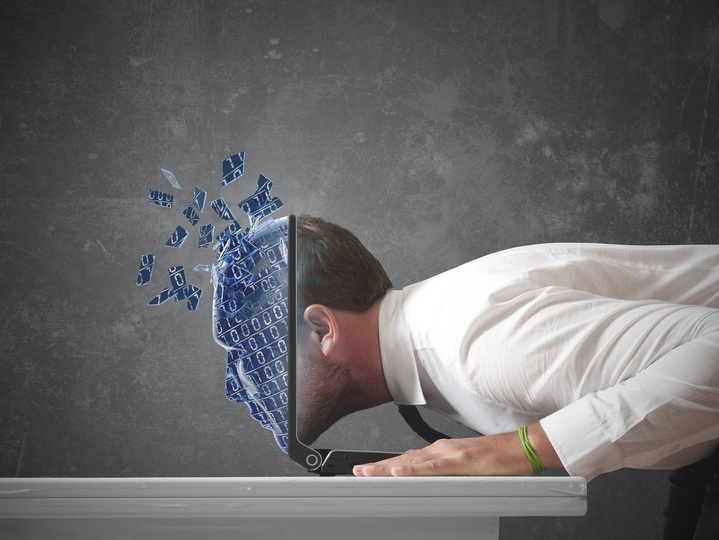
Продолжение: We’re always lost and that’s why it’s fun - Taiwan’s Digital Minister talks about how to live in the age of A.I.
Mr. Takahiro Ueda, a "cross-tech writer", who writes literary fiction in the early morning and works as a board member of an IT company during the day, invites artists and technologists to talk about "Art & Tech". Today’s conversation is with Audrey Tang, Taiwan's Digital Minister and a world-renowned programmer. Mr. Ueda and Ms. Tang discuss the future of the world, in light of the IT evolution. While Ms. Tang sees Doraemon as her vision of the future, Mr. Ueda has a darker vision that he repeatedly refers to as “the Sea of Flesh” in his novels. (Editor: Nobuyuki Yajima, Interpreter: Yumi Oishi)

Ueda:During the day, I work at an IT company I founded. In the morning I write literary fiction, novels with an emphasis on artistry, which we call "pure literature” in Japan. People know me as an eccentric novelist.
Note: Mr. Ueda joined an IT company founded by his friend when he was a college student and continues to work there as an executive in charge of alliances and public relations. He goes to bed between 8 and 9 p.m. and wakes up between 3 and 4 a.m. to write novels. He is currently working on his second full length novel, which will be published between 2020 and 2021.
Audrey:There are a lot of similarities between writing code, especially large programs and architectures, and writing novels and poetry. They both have to rhyme and be synthetically correct, and also carry semantics. So I don’t find it strange at all, I think it is the most natural of things. Just like our vicinity which is very natural.
Note: In the book, Audrey Tang: The Future of Digital and AI (President, Inc.), Ms. Tang, who is a renowned programmer, says, "As we enter the digital age, a literary background becomes essential and more important. In order to write an ideal program, you have to translate the concepts in your mind into written form. This is the same as in the world of literature. The only difference is that the code of programming is different from the rhyme in literature.
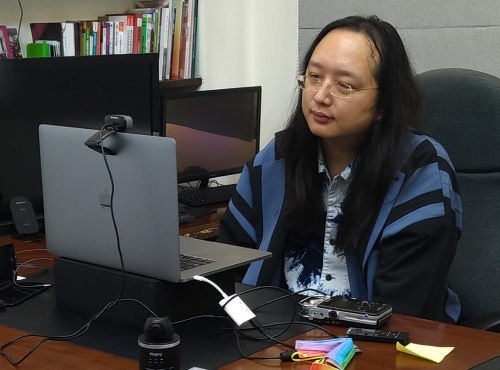
Audrey Tang
Audrey Tang, Taiwan's Digital Minister, was born in 1981 in Taipei. She started learning Perl at the age of 12. She dropped out of middle school at 15 and founded several start-ups as a programmer. At 19, she established her own software company in Silicon Valley, U.S.A. In 2005, became widely known for her contribution to the development of the Perl 6 (now known as Raku). She joined Apple in 2014, where she worked on high-level AI projects such as Siri. In October 2016, she joined the Executive Yuan (Cabinet) of Tsai Ing-wen, where she became the Digital Minister (cabinet member) in charge of digital affairs, working across departments to promote the digitization of government and politics. In 2019, she was named one of the top 100 global thinkers by Foreign Policy. She is the author of Audrey Tang: The Future of Digital and AI (President Publishing). (Photo: Yao Chiaomei)
Ueda:Thank you, Audrey. I have an obsessive view of the world which I write about in my novels repeatedly, but it might be difficult to understand. If you have any questions, please ask.

Takahiro Ueda
Takahiro Ueda was born in Hyogo Prefecture in 1979. After graduating from the Faculty of Law at Waseda University, he co-founded an IT company of which he is currently a board member. He made his debut as a writer of pure literature in 2013, winning the 45th Shincho New Writers Award for The Sun. In 2015, he won the 28th Yukio Mishima Award for My Lover, and in 2018, he won the 68th Art Encouragement Prize for New Talent from the Minister of Education, Culture, Sports, Science and Technology for Tower and Gravity. In 2019, he won the 160th Akutagawa Award for Nimrod. He is the author of The Sun and the Planets, My Lover, A Friend from Another Country, Tower and Gravity, Nimrod, and Q. (Photo: Nikkei xTECH)

Taiwan and the Ghosts of History
NEW YORK – Would the United States be prepared to risk a catastrophic war w... →
Audrey:You mean, it’s beyond translation? It would be better if we can converse directly in Japanese, but I see. We also have an interpreter here who used to work with the president’s press. I’m sure that nothing is impossible to translate with a sufficient number of translators. It’s called collective intelligence.
Note: Collective intelligence refers to the intelligence that is created when multiple people work together.
Ueda:I think you and I have a lot in common, such as IT, entrepreneurship, and literature. We are also of the same generation, and I hope we can have fun talking about various topics, without any fixed agenda.
Audrey:OK, that sounds very much natural, and I’m very happy that we are meeting in this natural session without having to wear a mask, because if this were real, we are too close.
Note: Ms. Tang, in the office of Taiwan's Digital Minister (equivalent to a Japanese cabinet minister) and Mr. Ueda, in the conference room at Nikkei BP's headquarters in Japan, spoke via Skype, Ms. Tang speaking in English and Mr. Ueda in Japanese, with simultaneous interpretation.
The future as seen in Doraemon
Ueda:We just took a look at the 1000th issue of the Nikkei Computer magazine. The main topic of the article was "Doraemon".
Note: Nikkei Computer, which was first published in 1981, published its 1000th issue (October 3, 2019) in October 2019. It explores the extent to which the "secret tools" provided by Doraemon, the cat-like robot from the future in the manga "Doraemon," can be created in real life with today’s technology. Before we began our conversation, I showed Ms. Tang the 1000th issue of the magazine. In her own book, Ms. Tang says, "If you want to imagine what the spread of AI will look like in society, Doraemon is a good example. In Audrey Tang: A Letter to Freedom (Kodansha), she replied, "If I could ask Doraemon to give me a tool, I would ask for a “Moshimo Box”.
Related article: “Doraemon and AI,” Nikkei Computer's First 1,000th Issue Anniversary
Audrey, you often talk about Japanese culture, such as Doraemon. Do you have any recent manga or anime that you find interesting?
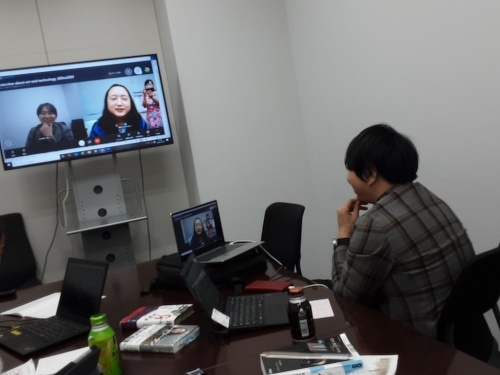
(Photo: Nikkei xTECH)
Audrey: I think I also quoted from the One Punch Man. When someone asked me why I am doing my work as a Digital Minister, I said I am a Digital Minister for fun.
Note: One Pan Man is a manga that has been serialized on the website since 2009. A remake of this manga, One Punch Man (drawn by Yusuke Murata), is serialized in Tonari no Young Jump(Shueisha). The English title of the remake is One Punch-Man. The protagonist, Saitama, can defeat any enemy with a single punch. He is, however, bound to a certain sadness precisely because he is so strong. His famous punchline is, "I work as a hero as a hobby.” Alluding to this, Ms. Tang’s answer is "I'm a minister for fun.”
Ueda:I love One-Punch-Man too. An editor once said to me, "Mr. Ueda, you look like One-Punch Man”.
(Ms. Tang holds up her left hand in the One-Punch-Man pose)

What to Do About Eurozone Sovereign Debt
ROME/EDINBURGH – The eurozone needs a new common policy to manage the sover... →
Since there are fewer people walking around outside in Japan, I have been watching a lot of videos on Netflix and Amazon Prime. I've also started watching Japanese anime, which never used to watch much. I heard that Demon Slayer is very popular in Taiwan. What do you think about it?
Note: Demon Slayer is a manga by Koyoharu Gotoge, serialized in Weekly Shonen Jump. It was made into an animated television series, and an animated film Demon Slayer: Infinity Train was released on October 16, 2020, and became the number one box office hit in Japan on December 27, 2020. In Taiwan, it was released on October 30, 2020 and became the highest-grossing anime film ever in Taiwan on November 15, 2020.
Audrey:I’ve heard about it but I haven’t watched it yet. I’ve watched the Ghost in the Shell though, not just the TV series, but also the movie adaptations. Also Neo Genesis Evangelion.
Note: Ghost in the Shell is a science fiction manga by Shiro Masamune. It was first published in Young Magazine Kaizokuban (May 1989). An animated feature film was released in 1995, and an animated television series in 2002. Neon Genesis Evangelion is a science fiction TV anime directed by Hideaki Anno, which aired from October 1995. A manga and a theatrical film has also been produced.

(Photo: Yao Chiaomei)
Ueda: You must be very busy right now, Audrey. How do you make time to watch all of them?
Audrey: I watched them before becoming the Digital Minister.
Ueda: I see. Demon Slayer is a recent anime, so I guess you are too busy to watch it now.
Audrey:I did watch a recent film, which was called Tennet. I watched it and only felt it and didn’t think about anything, because I watched the midnight session.

Next Steps for a People’s Vaccine
NEW DELHI – The Biden administration’s decision to stop opposing a proposed... →
Note: Tennet is a science fiction film directed, written and produced by Christopher Nolan. It was released in the United States and Japan in September 2020. Nolan directed the new Batman series in the 2000s. He is known for distancing himself from digital technology, sticking to shooting on film, and not using the Internet or e-mail.
So after I watched the film, I just went to sleep and slept for the longest hours in the whole year. I slept for more than 10 hours. After I woke up, everything made sense. It all connected in my mind, as though sleeping is magical.
Note: In her book, Ms. Tang says, “Before I go to bed, I read all the documents I need for my work. I read everything, but I don't make any decisions. When I'm done with the input, I go to bed thinking, 'when I wake up tomorrow, I have to come up with an answer to this problem.’ When I wake up the next morning, I have the answer in my head.” According to Audrey Tang: The Seven Faces of a Genius IT Minister (written by Iris Chu and Zheng Zhonglang, Bungeishunju), Ms. Tang "works from 7 a.m. to 7 p.m., walks to work these days, and rarely goes out drinking at night.” Every day, she makes sure to answer all her e-mails before going to bed and gets seven and a half to eight hours of sleep.
Ueda: It sounds like a type of sleep study (laughs). I've seen Interstellar and Inception but haven't seen Tennet yet. It sounds like I should go and see it though.
Note: Both movies are directed by Christopher Nolan. Inception was released in 2010 and Interstellar was released in 2014.
Audrey:Yes, if you like interstellar in particular, then you will probably like Tennet. I’ve also watched Inception and Interstellar.
Ueda:I haven't been to the cinema much recently because of COVID-19, but that is slowly changing. I like Nolan’s work such as Interstellar because it depicts science fiction (SF) and modern society in a connected way. It's not just fantasy, it's science fiction at just the right level, and I find it very interesting.
The world turning into “the Sea of Flesh”
Ueda: My novels are literary fiction but with a touch of science fiction. One of the things I like to write about repeatedly is the vision I call "the Sea of Flesh”. In short, this means human becoming one single mass. It's like the end of Neon Genesis Evangelion or AKIRA.
Note: AKIRA is a science fiction manga by Katsuhiro Otomo, serialized in Weekly Young Magazine since 1982, and an animated film was released in July 1988.
What used to be only a dream and an unreality when Neon Genesis Evangelion and Akira were created is now becoming a reality in today's society.
With the development of IT and bioengineering, we may be able to become identical to others, such that we are others and others are us. Then, I feel that humanity will finally become one. I call this "the Sea of Flesh" and have pursued it in several novels.
Note: The Sea of Flesh first appeared in Ueda's second novel, The Planets, and has been described in his following works, such as The World Without Gravity, Nimrod, and Q. In Nimrod, an Akutagawa Prize-winning novel, Ueda writes, "In order to maximize productivity, they unraveled their individuality and melted into one…With their shared personal consciousness and updated ethics through information technology, they will not hesitate to adapt their bodies to the transcendental value standards of the individual. The long novel Q depicted the world coming together and ending through the process of abolishing lifespan, the individual, and language. In 2018, "the Sea of Flesh," based on Ueda's Tower and Gravity, was performed at the Honda Theatre in Shimo Kitazawa, Tokyo, as part of the 40th anniversary of Office 3〇〇.
For example, I believe that the ending of Evangelion is a future that must be avoided. What I depict in my novels, in the form of pure literature, is an image of the future that we must prevent from happening.
Audrey, do you feel a kind of fear of humanity becoming united?
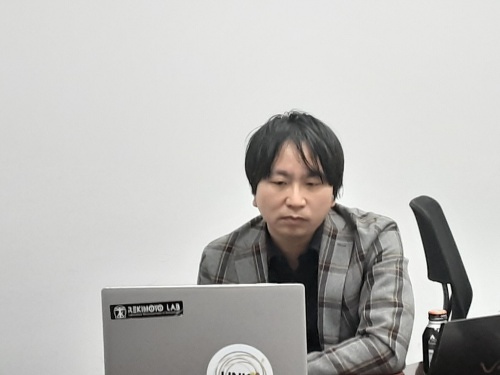
(Photo: Nikkei xTECH)
Audrey: I call this the internet of beings. I didn’t invent this term. It’s from Stan Shee from Acer corp., one of the heroes of personal computing from Taiwan. According to him, the Internet of Things connectes machines, but digital is about connecting people to people. The two together make the internet of beings.
Note: Shi Zhenrong (施振榮, Stan Shih = Stan Shih) is the co-founder and current honorary chairman of Hong Go (Acer), a leading IT company in Taiwan. In his keynote speech at the Taipei International Computer Exhibition (COMPUTEX) 2015, he said that the Internet of Beings and the Internet of Things are responsible for intelligence and information and data respectively, enabling people to gain insight.

The Two Sides of Chinese GDP
CHICAGO – Economic reporting about China focuses far too much on total GDP ... →
Now, of course, if we are connected as we are right now, we are overlapping a little bit on the screen, quite literally. But if I move toward here, I will cover your face and your face will cover mine and that’s too close. We can’t have a conversation if your face or my face is on top of each other. Therefore, shorter is better for the internet of beings because shorter means more rapid response and more empathy. But if it is too short, then communication is not possible. So there is also an innate idea of boundary in the internet of beings.
Ueda: That's interesting. It reminds me of what Susan Sontag said, "Time exists so that everything doesn’t happen all at once," and "Space exists so that it doesn’t all happen to you". I think that this is also about boundaries. It makes me realize that now is the time to rethink and reexamine the value of boundaries.
Note: Susan Sontag is an American writer. She left many critiques and essays in addition to her creative writing. She was highly acclaimed as both a writer and a critic and was active as a liberal intellectual. Many of her essays, which are harshly critical of society, have been translated into Japanese. Her many books include In the Same Time and I was reborn: Diary and Notes 1947-1963.
Audrey: When we talk about digital, I was looking at your digits, I mean the fingers are literally our digits, so we are not binary beings. We are decimal beings because we have 10 digits. That’s where digital came from.
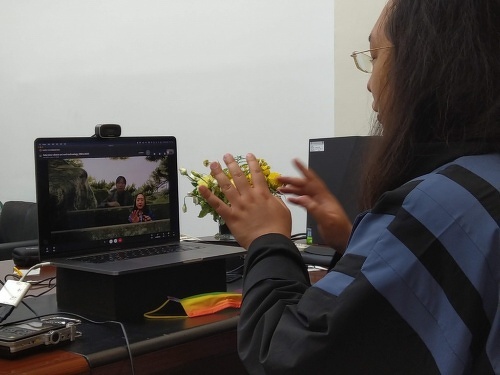
(Photo: Yao Chiaomei)
So, just by putting the digits in a different place, like you were doing this, and your other hand was doing this. Your different digits were having different sensations.
Now, imagine if you are like Doraemon, then that’s binary, you only have two digits, and still, that will provide different perspectives.
But if the Sea of Flesh is just one digit, it loses the plurality and becomes the singularity.
Note: The word "plurality" means that different people are equal in their differences. In the poem in which Ms. Tang explains her duties as a Digital Minister, there is a passage that goes like this:
When we hear "the Singularity is near", let us remember: “Plurality is here.“
Plurality, which is the digital vision, makes sure that we can feel the same phenomena, but with different qualia. But just like the different fingers all connect back to the same nerve system, so are the individuals connected to the same spirit, the same Daimon.
Note: Qualia are properties that are subjectively perceived by the individual. There is an ongoing debate in the philosophical and scientific communities as to why humans have qualia. Daimon is a supernatural being that sits between God and man, bridging the two. Ms. Tang points out that even though people are digitally connected, each finger has a different sense and a different qualia.
Ueda:I don't know exactly how it may happen, but I worry that people will be lumped together and be perceived in a uniform way.

10 Lessons Business Leaders Can Learn From How Biden Is Managing The Covid Crisis
President Joe Biden has had some important successes in managing the Covid ... →
Note: In Ueda's middle novel, The Tower and Gravity, he writes about his discomfort with the fact that the "reaction speed of people’s thoughts is accelerating" due to social networking services (SNS), but "it seems as if people are lumped together and thinking about the same thing over and over again.”
In contrast to "the Sea of Flesh," I have repeatedly written about "Rejected People" in my novels. They are mud puppets that man has made to resemble their former selves, and they trace conventional human activities to these rejected people.
Note: In Ueda's long story Q, the protagonist, asleep in a refrigerator, wakes up in the age of “the Sea of Flesh” and tries to end the world with the “Rejected People” as the last human beings.
In other words, there is a direction that unites human beings into one and a direction that resists it, and this is where struggle and rebellion arise. This is the basis of human activity. It would be more efficient to lump all human beings together, but it seems scary to me, and my writing is about expressing this.
Expanding people with Digital Double
Audrey: Yes, but we have both been part of other people too. We have been part of another person’s body for at least eight months, if I’m not mistaken, so it’s not like a scary thing, I mean, we have been there.
Note: Humans are in the mother's womb for about eight months.
Ueda: That's true, but still, I can't help but feel that history would end if humans become one.
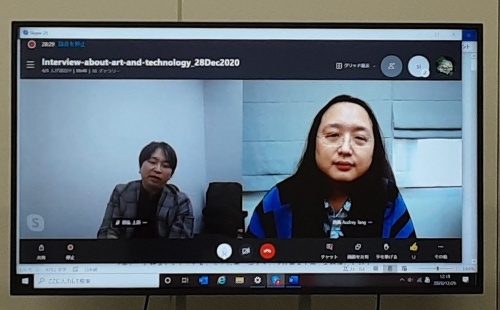
(Photo: Nikkei xTECH)
Audrey:On the other hand, there’s nothing preventing individuation even within the same organism. I’m not talking about my fingers suddenly becoming autonomous, but I’m talking about the idea of a digital twin.
Note: A digital twin is technology that allows us to virtually recreate the behavior of real things. We can collect data on cars, planes, factories, cities, etc., create twins (Ms. Tang calls them doubles) on a computer, and simulate the future by moving forward in time.

How China’s Digital Currency Could Fracture Global Finance
U.S.-China decoupling is impacting a wide range of industries. Supply chain... →
There could be cases, for example, when I learn very intently how to play chess, or quantum chess. Then the fingers, the digital movement of my moves of course gets reflected to the digital double. Nowadays quantum chess is played on digital platforms only, and even regular chess is mostly played on digital platforms now.
Note: In Quantum Chess, the pieces are in a quantum state and the player does not know what the piece is. When you move a piece, you know what it is. There are several quantum chess games available on the Internet.
And when the assistive intelligence learns the part of my mind that works on chess, eventually it becomes my double and all the chess playing can be then deferred to the assistive intelligence like a real assistant.
So this is a case of an organism that then forks away part of itself, so that the main organism doesn’t need to worry about playing chess anymore.
Note: In her book, Ms. Tang writes, "AI stands for artificial intelligence, but I think it's better to think of it as assistive intelligence. AI should be used to promote social innovation and improve human society.”
Ueda: Is it a kind of outsourcing?
Audrey: That’s one way of looking at it, but then the individual that’s forked off, if we call it alpha zero or something, it may also grow and have its own experience of becoming a machine that plays not only chess but also pretty much any Atari game.
Note: AlphaZero is a system developed by DeepMind, a British company affiliated with Alphabet, Google’s parent company. It is a general-purpose version of AlphaGo Zero, which became famous for beating humans in Go, and can play Go, Shogi, and chess. Atari is an American manufacturer of game consoles and software.
Will there be a society based on “Exchange Mode X”?
Ueda: In your book, you mentioned "Exchange Mode X". It means that with the development of technology, borders will disappear and the possibility of new modes of exchange will expand, but at the same time, the risk of disparity and confusion will increase.
You said that “trust between individuals will be the key to exchange mode X, but can trust between individuals really drive the world? Until now, the world has been driven by the balance of power between nations, but will the world evolve through the balance between individuals?”
Note: The exchange style X was proposed by a philosopher Kojin Karatani in The Structure of World History (Iwanami Shoten) and other books. There are "reciprocal exchange," "plunder and redistribution," and "commodity exchange" as modes of exchange between people, which are combined to form social components such as "nation," "state," and "capital.” In addition, although it does not yet exist, there may be a "free and mutually beneficial" mode of exchange X. Based on this mode of exchange, he envisages a society that goes beyond the current state and capital. In her book, Ms. Tang writes that Mode X "has definitely been a major influence," on her work and she believes that it can be realized through the power of digital technology. The question, she says, is "how to build trust" between strangers in the exchange of knowledge.
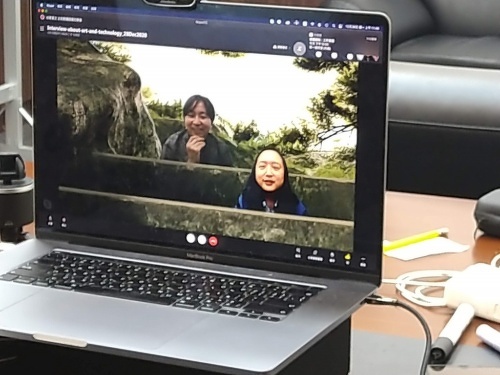
(Photo: Yao Chiaomei)
Audrey:This is what I refer to as the People, Private, Public, Partnership, with the people, first.
If it is the economic sector, the business sector, doing the technology, then it may save lives, of course, automatic driving saves lives. But it may also kill lives if it is hijacked by a terrorist. So this tends to be a large scale technology. And the idea of pro- or anti-social effects may not be felt by the inventor.
But if we approach technology from the social sector, from the social norm, if someone says “Hey, wear a mask to protect yourself.” And someone else says, “Hey, wear a mask to protect yourself from your own hands.” And someone else says “Wear a mask to protect yourself from your own unwashed hands.”
Every word makes it more prosocial, and there is no bad effect from this kind of social innovation. So that’s the X mode of exchange.
Note: The "4Ps" mentioned by Ms. Tang can be interpreted as follows. People come first. The private sector, which means private companies, operates exclusively in a style of "commodity exchange" and scales up according to the logic of capital. In the public social sector, on the other hand, individuals become partners, and this has a common sense and positive effect. The question is not whether trust between individuals can move the world, but how it can be put into practice.
(To be continued in "A Conversation with Audrey Tang (Part 2)")
Editor’s Note
As the extremely busy Audrey Tang and Takahiro Ueda were set to talk, we asked Nikkei xTECH(Cross-Tech)readers to submit their questions to Ms. Tang. The most frequently asked questions were about the impact of IT and AI. For example, "Does the evolution of IT contribute to people's happiness?” "What benefits (or harms) do you think the development of AI will bring to biodiversity?" "Do you see a day in the future when people will be dominated by ICT?”
There were also questions such as, "I think humanity is just repeating the same things over and over again, can’t we update our society?" and "I think humanity is a failure of biological evolution and I am despairing about the future of humanity, but can we imagine a brighter future?”
Ms. Tang's answer was “Doraemon” or "Assertive Intelligence”. In her book, she writes, "To ask whether it would be good or bad for AI to surpass humans, … it means that we cannot make an accurate value judgment if such a question is asked at this stage. The important thing is to think carefully about 'what we can do to prevent that from happening' before making such assumptions.”
As Ms. Tang pointed out, one of the answers to the question of “what we should do” is to be aware of the boundaries between yourself, AI and social networking sites. Ms. Tang doesn't have a smartphone, so she doesn’t have to scroll through social networking sites. Mr. Ueda does not use Twitter and limits his Facebook posts to his friends.
Nobuyuki Yajima, Nikkei BP Research Institute
*The original article is the collaborated piece between Nikkei xTECH and Forbes Japan.
*Nikkei xTECH, run by Nikkei BP, is a digital media focusing on technology whose main readership are engineers as well as business leaders eg., working in various industrial categories such as automobile, electronic, machinery, architecture and civil engineering.

